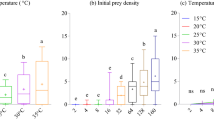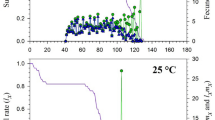Abstract
The functional response ofCyrtorhinus lividipennis Reuter attacking the brown planthopper(Nilaparvata lugens (Stål.), BPH) eggs on rice was determined at six constant temperatures of 20°C, 23°C, 26°C, 29°C, 32°C and 35°C. Rogers’ (1972) random predator equations were fitted to the data for each temperature separately. The equation model adequately described a Holling’s Type II functional response forC. lividipennis and produced biologically realistic estimates of attack rates and handling times at five experimental temperatures between 20°C and 32°C. However, at 35°C, a negative handling time(Th = - 0.0029) was produced. The effect of temperature was incorporated in to Rogers’ equation by making the attack rate(a) and handling time(Th) functions of temperature within the range 20°C to 32°C. The attack rate and handling time were fitted as hyperbola and reciprocal hyperbola functions of temperature respectively. The temperature incorporating fourparameter composite model fitted the combined data as well as did separate Rogers’ equations based on the parameter estimates.
Similar content being viewed by others
References
Bae, S.D. (1995) Effect of temperature on the biology of brown plant-hopper,Nilaparvata lugens (Stål.), and its symbiote population. Ph. D. Thesis in Entomology, Gyeong-Sang National University, Chlnju, Korea.
Cave, R. D. and M. J. Gaylor (1989) Functional response ofTelenomus reynoldsi (Hymenoptera: Scelionidae) at five constant temperatures and in an artificial plant arena.Entomophaga 34: 3–10.
Cheng, J. A., J. Holt and G. A. Norton (1994) A systems approach to planthopper population dynamics and its contribution to the definition of pest management options, pp. 635–655. In R. F. Denno and T. J. Perfect (eds.)Planthoppers: their ecology and management. Chapman and Hall, New York.
Dobel, H. G. and R. F. Denno (1994) Predator-planthopper interactions, pp. 325–399. In R. F. Denno and T. J. Perfect (eds.)Planthoppers: their ecology and management. Chapman and Hall, New York.
Dyck, V. A. and B. Thomas (1979) The brown planthopper problem, pp. 3–17. In International Rice Research Institute (ed.)Brown planthopper: threat to rice production in Asia. International Rice Research Institute, Los Banos, Philippines.
Everson, P. (1980) The relative activity and functional response ofPhytoseiuluspersimilis (Acarina: Phytoseiidae) andTetranychus urticae (Acarina: Tetranychidae): The effect of temperature.The Canadian Entomologist 112: 17–24.
Flinn, P. W. (1991) Temperature-dependent functional response of the parasitoid,Cephalonomia waterstoni (Gahan) (Hymenoptera: Bethylidae) attacking rusty grain beetle larvae (Coleoptera: Cucujidae).Environmental Entomology 20: 872–876.
Heinrichs, E. A., F. G. Medrano and H. R. Rapusas (1985)Genetic evaluation for insect resistance in rice. International Rice Research Institute, Los Banos, Philippines.
Heong, K. L., G. B. Aquino and A. T. Barrion (1992) Population dynamics of plant- and leafhoppers and their natural enemies in rice ecosystems in the Philippines.Crop Protection 11: 371–379.
Heong, K. L., S. Bleih and A. A. Lazaro (1990) Predation ofCyrtorhinus lividipennis Reuter on eggs of the green leafhopper and brown planthopper in rice.Researches on Population Ecology 32: 255–262.
Heong, K. L. and I. Domingo (1992) Shifts in predator-prey ranges in response to global warming.International Rice Research Newsletter 17: 29–30.
Heong, K. L., Y. H. Song, S. Pimsamarn, R. Zhang and S. D. Bae (1995) Global warming and rice arthropod communities, pp. 326–335. In S. Peng, K. T. Ingram, H. U. Neue and L. H. Ziska (eds.)Climate change and rice. Springer-Verlag, Berlin Heidelberg, Germany.
Holling, C. S. (1959) Some characteristics of simple types of predation and parasitism.The Canadian Entomologist 91: 385–398.
Hyams, D. (1996) A comprehensive curve fitting software system for Windows™ Copyright (c) 1995–1996 Daniel Hyams.
IPCC-Intergovernmental Panel on Climate Change (1990) Introduction, pp. 1–2. In J. T. Houghton, B. A. Calandar and S. K. Varney (eds.)Climate change: the IPPC scientific assessment. Cambridge University Press, Cambridge, UK.
IRRI-International Rice Research Institute (1995)World rice statistics 1993–94. IRRI, Los Banos, Philippines.
Kiritani, K. and K. Naba (1994) Development and implementation of rice IPM in Japan, pp. 713–731. In E. A. Heinrichs (ed.)Biology and management of rice insects. Wiley Eastern, New Dehli, India.
Laba, I. W. and K. L. Heong (1996) Predation ofCyrtorhinus lividipennis on eggs of planthoppers in rice.Indonesian Journal of Crop Science 11: 40–50.
Mack, T. P. and Z. Smilowitz (1982) Using temperature-mediated functional response models to predict the impact ofColeomegilla maculata (DeGeer) adults and 3rd-instar larvae on green peach aphids.Environmental Entomology 11: 46–52.
McCaffrey, J. P. and R. L. Horsburgh (1986) Functional response ofOrius insidiosus (Hemiptera: Anthocoridae) to the European red mite,Panonychus ulmi (Acarina: Tetranychidae), at different constant temperatures.Environmental Entomology 15: 532–535.
Peng, S., K. T. Ingram, H. U. Neue and L. H. Ziska (eds.) (1995)Climate change and rice. Springer-Verlag, Berlin, Germany.
Rogers, D. (1972) Random search and insect population models.Journal of Animal Ecology 41: 369–383.
SAS Institute (1988)SAS/STAT user’s guide, release 6.04. SAS Institute, Cary, North Carolina, USA.
Sivapragasam, A. and A. Asma (1985) Development and reproduction of the mirid bug,Cyrtorhinus lividipennis Reuter (Heteroptera: Miridae) and its functional response to the brown planthopper.Applied Entomology and Zoology 20: 373–379.
Solomon, A. M. and H. H. Shugart (eds.) (1993)Vegetation dynamics and global change. Chapman and Hall, London.
Song, Y. H. (1995) Risk assessment for the monsoonic migratory pests of rice in Korea, pp. 101–112. In N. Hokyo and G. Norton (eds.)Proceedings of international workshop on the pest management strategies in Asian monsoon agroecosystems, November 15–18, 1995. Kyushu National Agricultural Experiment Station, Kumamoto, Japan.
Teramoto, T., T. Nakasuga, and K. Yokomizo (1996) Seasonal prevalence of occurrence of the brown planthopper,Nilaparvata lugens, and predacious mirid bug,Cyrtorhinus lividipennis in Nagasaki, Japan, pp. 55–62. In N. Hokyo and G. Norton (eds.)Proceedings of international workshop on the pest management strategies in Asian monsoon agroecosy stems, November 15–18, 1995. Kyushu National Agricultural Experiment Station, Kumamoto, Japan.
Thompson, D. J. (1978) Towards a realistic predator-prey model: The effect of temperature on the functional response and life history of larvae of the damselfly,Ischnura elegans.Journal of Animal Ecology 47: 757–767.
Walker, B. and W. Steffen (eds.) (1996)Global change and terrestrial ecosystems. Cambridge University Press, UK.
Way, M. J. and K. L. Heong (1994) The role of biodiversity in the dynamics and management of insect pests of tropical irrigated rice — a review.Bulletin of Entomological Research 84: 567–587.
Zhang, R., K. L. Heong and I. T. Domingo (1996) Relationship between temperature and functional response inCardiochiles philippinensis (Hymenoptera: Braconidae), a larval parasitoid ofCnaphalocrocis medinalis (Lepidoptera: Pyraliidae).Environmental Entomology 25: 1321–1324.
Author information
Authors and Affiliations
Corresponding author
Rights and permissions
About this article
Cite this article
Song, Y.H., Heong, K.L. Changes in searching responses with temperature ofCyrtorhinus lividipennis reuter (Hemiptera: Miridae) on the eggs of the brown planthopper,Nilaparvata lugens (Stål.) (Homoptera: Delphacidae). Res Popul Ecol 39, 201–206 (1997). https://doi.org/10.1007/BF02765266
Received:
Accepted:
Issue Date:
DOI: https://doi.org/10.1007/BF02765266




